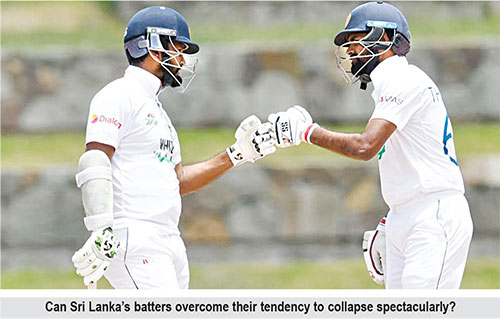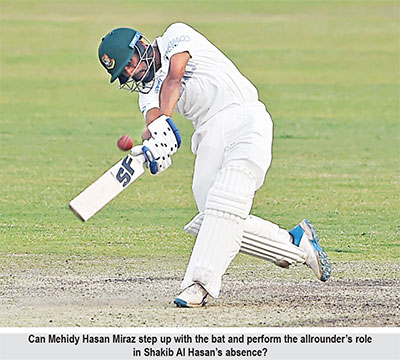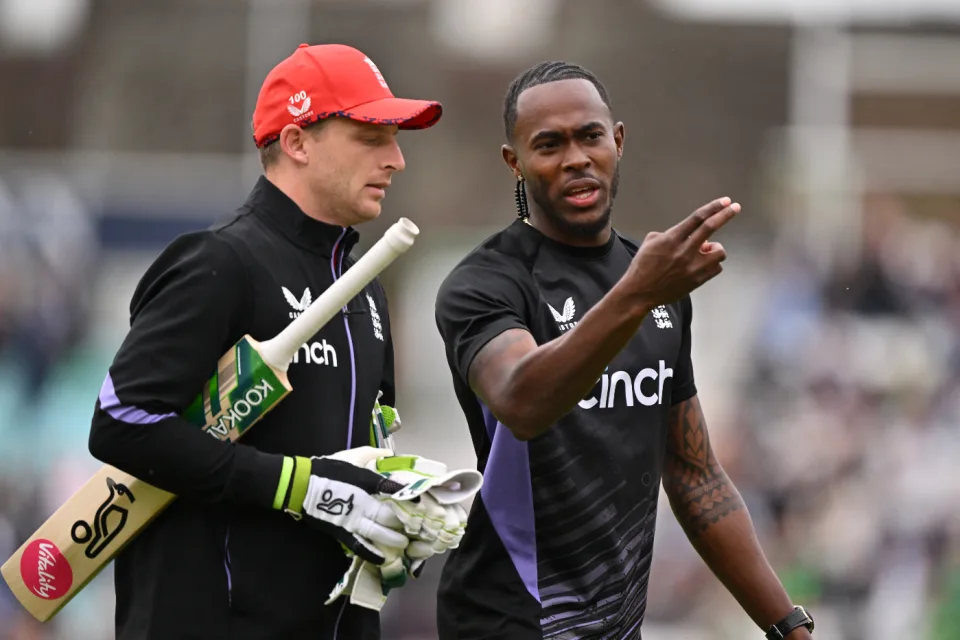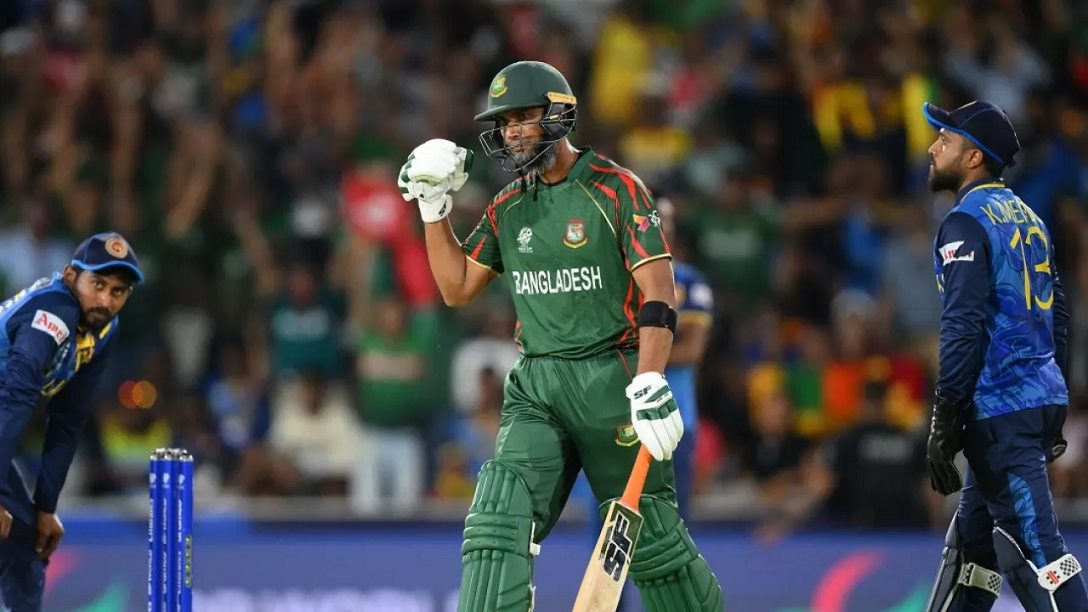Sports
Three questions for Sri Lanka, three questions for Bangladesh

The two-match series in Pallekele will present two uncertain teams a stiff examination of their Test-match mettle Sri Lanka are seventh in the Test rankings, and have not won a match against top-nine opposition since August 2019. Bangladesh are ranked ninth and are coming off a difficult 2-0 Test defeat at home to West Indies. ESPNcricinfo looks at some of the biggest challenges the two teams will attempt to overcome through the course of their two-Test series in Pallekele.
Sri Lanka
Spin bowling
To win in Sri Lanka, spinners generally need to take a lot of wickets. One of Sri Lanka’s problems has been that since the retirement of Rangana Herath, their spin attack has fallen away somewhat. Where their spinners collectively averaged 27.80 at home in Herath’s last three years, they average 32.62 since his exit.
In this series, they will be without Lasith Embuldeniya, their most promising slow-bowling prospect, after he picked up a serious soft-tissue injury in the Caribbean. They are also without Dilruwan Perera, whose effectiveness had dipped substantially (he averages 32.17 at home since Herath’s retirement in November 2018). They’ll likely rely on wristspin via Wanindu Hasaranga or Lakshan Sandakan (or both), with Dhananjaya de Silva’s offspin in support. But neither Hasaranga nor Sandakan have seemed up to leading a Test attack so far, partly because their control has been inconsistent between spells.
Although this series is being played in Pallekele where seamers may play more of a role than they do in Galle, Sri Lanka will likely need big wickets from the spinners too.
Batting collapses
Although since December Sri Lanka’s batting has been sporadically impressive, such as in the first innings at Centurion or the second innings at North Sound, these successes have been interspersed with dramatic, harrowing collapses. In their last 12 Test innings, Sri Lanka have failed to make 200 on five occasions. Two of the worst nosedives came in their last series at home, against England, against modest bowling, when they were out for 135 and 126 – innings in which they surrendered the series. If they go into self-destruct mode again, they could cede another match.
Fitness
Coach Mickey Arthur has been adamant that players raise their standards, and have ruled certain players out of contention purely on fitness grounds. And still, Sri Lanka’s long history with muscle and soft-tissue injuries continues to plague them. In addition to being without Embuldeniya in this series, they are also missing seamer Kasun Rajitha, while rookie batter Pathum Nissanka has been struggling with a niggle as well (but is expected to be fit for the series). There are many theories on why injuries seem to plague Sri Lanka more than most other teams. Some find fault with the conditioning, others point to a lack of recent cricket, or to developmental issues going back to the players’ formative years. Whatever the case, rare is the series from which Sri Lanka emerge with all their key players intact.
Bangladesh
Overseas troubles
 Bangladesh’s Test record is such that it is considered inevitable they will not threaten on foreign soil. They have won only one away Test in the last five years, and since that one win, which came in Sri Lanka in 2017, they have lost each of their nine Tests on the road, all by heavy margins.
Bangladesh’s Test record is such that it is considered inevitable they will not threaten on foreign soil. They have won only one away Test in the last five years, and since that one win, which came in Sri Lanka in 2017, they have lost each of their nine Tests on the road, all by heavy margins.
A big part of their problem is the inability to take 20 wickets abroad – a feat they have only managed five times in their history. Their spinners have been effective on favourable pitches at home, but these have left the fast bowlers with little to do. This lack of bowling at home translates into a lack of rhythm and effectiveness abroad. It has been eight years since a Bangladesh fast bowler won them an overseas Test.
The Shakib-sized hole
What would make it more difficult for Bangladesh in Sri Lanka this time is Shakib Al Hasan’s absence. His stature as a Test allrounder makes him particularly difficult to replace. Mehidy Hasan Miraz performed admirably against West Indies recently but he has a lot to do to earn the allrounder’s tag. This time the selectors have picked the 34-year old Shuvagata Hom as a batting allrounder when five years ago, during his last Test appearance, he was counted as a bowling allrounder. This is the sort of confusion that can arise when Shakib isn’t around; no Shakib is always an advantage to the opposition.
Catching
Bangladesh’s catching was one of the most worrying aspects of their disastrous New Zealand tour last month. They dropped ten catches in the ODIs and T20Is, which cost them results and momentum, and netted a bit of embarrassment as well. When the team returned from the tour, newcomer Nasum Ahmedoffered an explanation for the dropped catches that was the stuff of internet memes: “Their sky is very clear and their weather is nothing like ours.”
The real story, however, was different. The 2-0 home defeat to West Indies in February shook the team, leading to a team-wide lack of confidence. As is often the case in cricket, this lack of confidence made for a poor fielding side.
(ESPN Cricinfo)
Sports
England face Australia in the battle of champions

The first truly heavyweight clash of this expanded T20 World Cup format comes freighted with both history and subplots. A rematch of the 2010 World T20 final at Kensington Oval, the match pits Jos Buttler’s defending champions – who are aiming to become the first team to retain the trophy – against the Australian winning machine, victors at the 2021 edition and current world title-holders in Test and ODI cricket. And that’s before you throw in the Ashes for afters.
Already there is added pressure on England, after the rain in Bridgetown led to a share of the points in their opener against Scotland (and that having conceded 90 runs from 10 overs without taking a wicket in a tepid bowling display). Lose to their oldest rivals and it will leave their Super 8 prospects open to being waylaid by the perils of net run-rate calculations, or worse.
The Scotland match was the third abandonment in five suffered by England, after a rain-affected home series against Pakistan, which has clearly hampered their readiness for this campaign after almost six months without playing T20 together. It does not take much for a side to click in this format – and England looked in decent shape when they did get on the field against Pakistan – but Buttler will be anxious for things to go their way on Saturday, if only to avoid further questions referencing the team’s disastrous ODI World Cup defence last year.
Australia, under the laidback leadership of Mitchell Marsh would love nothing more than to add to the English sense of jeopardy – having helped bundle them out of the tournament in India on the way to taking the crown. Their head to head record is less impressive in T20 however, with England having won six of the last seven completed encounters, as well as that 2010 final.
Despite a wobble with the bat, Australia avoided mishap against Oman earlier in the week, the experience of David Warner and Marcus Stoinis shining through in difficult batting conditions. Surfaces in the Caribbean – not to mention those games staged in the USA – have already had teams scratching their heads; rather than the “slug-fest” England had prepared for, following a high-scoring tour of the Caribbean in December, it looks as if boxing smart may be the way to go.
Speaking of Warner, this could be the last time he faces up against England in national colours – and another match-winning contribution would likely reduce the chances of them meeting again in the knockouts. On the other side of the card is Jofra Archer, fresh from an emotional maiden outing at Kensington Oval and ready to take on Australia for the first time in any format since 2020. Can Mark Wood fire up England’s campaign, as he did during last summer’s Ashes? Will Pat Cummins be back to harass the old enemy once again? Seconds out, it’s almost time to rumble.
Cummins is set to return after being rested for the Oman game, which saw Mitchell Starc leave the field with cramp. Starc is understood to be fine and could keep his place – which would likely see Nathan Ellis miss out. Marsh is still not fit to bowl, with Australia likely to continue with the allrounder combination of Stoinis and Maxwell to give them cover.
Australia (probable XI): David Warner, Travis Head, Mitchell Marsh (capt), Glenn Maxwell, Marcus Stoinis, Josh Inglis (wk), Tim David, Pat Cummins, Nathan Ellis/Mitchell Starc, Adam Zampa, Josh Hazlewood
The one change England may consider is Reece Topley coming in for Wood, with the expectation that there will be some rotation among the seamers through the course of the tournament.
England (probable XI): Phil Salt, Jos Buttler (capt & wk), Will Jacks, Jonny Bairstow, Harry Brook, Liam Livingstone, Moeen Ali, Chris Jordan, Jofra Archer, Adil Rashid, Reece Topley/Mark Wood
[Cricinfo]
Sports
South Africa up against their bogey team in batter-unfriendly New York

Once is coincidence, twice is a clue, and three times is proof.
To paraphrase Agatha Christie, that is the narrative around South Africa’s meeting with Netherlands at this T20 World Cup.
The Dutch beat South Africa at the 2022 tournament and ended their semi-final hopes in a match where South Africa appeared to be sleep walking, and then beat them again at the 2023 ODI World Cup, where they exposed South Africa’s vulnerability in the chase. If they to do the treble, not only will Netherlands take the lead in Group D, but they will offer conclusive evidence of the threat they pose to Full Members, especially South Africa.
Of course, it will take some doing after South Africa’s opening performance against Sri Lanka, where they reduced their opposition to their lowest T20I total and chased it down in fairly straightforward fashion thanks to the most stable middle-order of their white-ball era. In Aiden Markram, Tristan Stubbs, Heinrich Klaasen and David Miller, South Africa have bankers and big-hitters and, for this match, they also have the advantage of experience. They’ve already played at Eisenhower Park, and have first-hand knowledge that run-scoring doesn’t come easily;Klassen said they are prepared to use their “cricket brains” and play “smarter cricket”.
But the conditions could be good news for Netherlands, who are not naturally a line-up of big hitters and build their innings on a foundation of turning ones into twos. In other words, they tend to take a slightly more conservative approach to batting, which may work well here, but they’ll be wary of the uneven bounce of the surface and will have to come up with plans to counterattack especially against South Africa’s seamers. Their own bowlers were exemplary in Dallas and will look to build on that performance against a line-up that will likely be more proactive than Nepal’s, but who they have managed to keep quiet not once, but twice in the past. Third time’s the charm, they say.
Anrich Nortje’s stunning return to form against Sri Lanka means South Africa may not have to tinker with the bowling combination, and Gerald Coetzee and Tabraiz Shamsi may have to wait their turns to get a game. The batting line-up should be unchanged, with no space for Ryan Rickelton yet.
South Africa: Quinton de Kock (wk), Reeza Hendricks, Aiden Markam, Tristan Stubbs, Heinrich Klaasen (wk), David Miller, Marco Jansen, Keshav Maharaj, Kagiso Rabada, Ottneil Baartman, Anrich Nortje
Conditions in New York may tempt Netherlands to include an extra seamer and they have Kyle Klein in their squad. But it could come at the expense of a shortened batting line-up and they may not want to risk that.
Netherlands: Michael Levitt, Max O’Dowd, Vikramjit Singh, Sybrand Engelbrecht, Scott Edwards (capt, wk), Bas de Leede, Teja Nidamanuru, Logan van Beek, Tim Pringle, Paul van Meekeren, Vivian Kingma
[Cricinfo]
Latest News
Mustafizur, Rishad, Hridoy dazzle in Bangladesh’s tight two-wicket win over Sri Lanka

Nuwan Thushara’s last over brought Sri Lanka screaming back into the match,as he first bowled Rishad Hossain, and then nailed Taskin Ahmed in front of the stumps with a pinpoint swinging yorker. This left Bangladesh eight wickets down, with 12 runs still to get.
However, the experienced Mahmudullah was at the crease for Bangladesh, and despite some further nervy moments, pushed Bangladesh across the line off the last ball of the 19th over.
But this was a match chiefly decided by Bangladesh’s own outstanding bowling. Mustafizur Rahman was the best among them, using shorter lengths and his cutters efficiently, to claim figures of 3 for 17. Rishad Hossain’s three-for through the middle overs also kept Sri Lanka quiet.
Mustafizur was instrumental in Sri Lanka’s downward spiral through the middle overs, which culminated in a crash-and-burn end. Ultimately, their inability to find boundaries, or even rotate strike against good Bangladesh bowling resulted in their downfall. A score of 125 for 9 always seemed poor on a decent pitch, even if their bowlers made a match of it in the end.
Brief scores:
Bangladesh 125 for 8 in 19 overs (Towhid Hridoy 40, Litton Das 36; Dhanajaya de Silva 1-11, Nuwan Thushara 4-18, Wanidu Hasaranga 2-32, Matheesha Pathirana 1-27) beat Sri Lanka124 for 9 in 20 overs (Pathum Nissanka 47, Dhananjaya de Silva 21; Tanzim Hasan Sakib 1-24, Taskin Ahmed 2-25, Mustafizur Rahman 3-17, Rishad Hossain 3-22) by two wickets
[Cricinfo]












